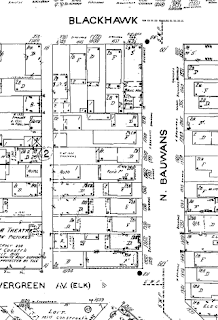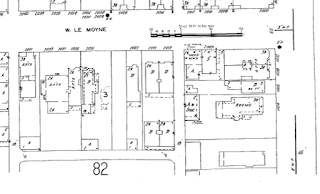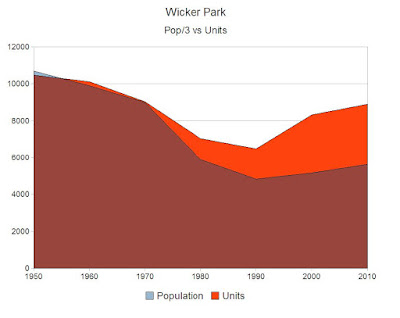Wicker Park’s
first renewal project would also be part of its last, although the two would be
separated by almost 30 years. In ‘55 and ‘56 they demolished a couple of dozen
homes on Mautene and Bauwans (two streets now almost completely lost to
history) to make way for some parking lots where they planned to put the
new shopping center.
This was noticed by some in the community and in’56 the East
Humboldt Park Planning and Conservation Commission was formed with the intent
of getting the area designated as a “Conservation District” The Illinois Urban
Community Conservation Act of 1953 and it’s clone, the Federal Housing Act of
1954 created these districts to allow urban renewal in areas not yet classified
as slums. It freed up federal money for land acquisition as well as for repairs
to existing structures. For the city however, it would have one fatal flaw, it
required community input.
The East Humboldt commission was headed by Valentine Janicki,
a local business leader, owner of the United Novelty Mfg Co. and future
president of the Polish Alma Mater Association. He was not without his own
agenda. He had his eye on 9 sq blocks of land his commission felt need to be
cleared. He also had political aspirations, after this he would parlay his
Polish and political connections into a seat on the sanitary district, where
like all good Chicago politicos he would eventually be jailed in a sludge
hauling kickback scheme.
In ’57 Mayor Richard J. Daley, conscious of the Polish vote
appointed him to the Community Conservation Board, the group that selected
which parts of the city would become conservation areas and in ’58 East
Humboldt Park, an area bounded by Grand, Fullerton, California, and the river
(later the expressway) would gain that distinction.
Without Janicki at the helm, the East Humboldt commission
drifted into obscurity. This was probably a good thing. The Community
Conservation Act was literally designed to be co-opted by private enterprise.
It was created to allow the University
of Chicago turn Hyde Park
into their personal compound and later was used by the Southtown Planning
Association in their goal of stemming black migration in Englewood.
The city started making a conservation plan but was playing
it close to the vest. Its next two clearance projects were several houses on
Damen for rebuilding the Wicker Park
School (now Pritzker) in 1960,
And a large parcel just to the north of this for the CHA
elderly high rise project at Damen and Schiller in 62 -63
These, and announcement of several clearance projects,
including the one in what we now call Noble Square, would be a wake up call.
Several church leaders, fearing the dispersal of their flock in 1962 formed the
Northwest Community Organization (NCO), a supergroup of smaller community
organizations and a member of Saul Alinsky’s Industrial Areas Foundation. The
local community group at the time, The Wicker Park Neighborhood Council aligned
themselves with the NCO.
The NCO managed to get several sympathetic people appointed
to the East Humboldt Park/Near Northwest
conservation area’s Conservation Community Council (CCC), a Mayorally selected body of
local citizens with oversight and veto power over the plans and recommendations
of the Dept of Urban Renewal for each conservation area. Together they would
battle the city to a halt at every turn.
In ’67 they battled the plans for the Tuley High (now
DeDiego) expansion. Although they wanted its expansion, the Board of Ed and the
DUR wanted it to go east across Clairmont to Oakley in the land they
preemptively downzoned for a park. The NCO felt the properties to the west were
in much worse condition and better candidates for demolition.
In ’68 the NCO would convince the Board of Ed to build a new
high school inside Humboldt Park,
but that would backfire. They would have to swap land to the park department.
You guessed it, the land they wanted to swap was the same blocks, Oakley to
Leavitt, Potomac to Hirsch they had downzoned. So the
NCO fought that too. In the end the city built Clemente on the site of an old
street car barn.
In ’69 the city produced its conservation plan for the area,
a vague document with large areas slated for demolition and the NCO went
apesh!t. They wrote their own plan. the “People’s Plan” It called for only spot
removal of dilapidated buildings, no new construction over 3 stories and, the
dealbreaker, 90% of all new construction to be affordable housing.
Through their seats on the CCC they vetoed any plan that
didn’t conform to theirs.
Daley, tired of this stalemate, tried to break their power
by appointing five of his own people to the CCC in place of theirs, and the NCO
took him to court. They won and the city pretty much threw up its hands.
1973’s Chicago 21 plan did not
include anything west of Ashland.
Despite this victory NCO would play a roll in the extensive
loss of Wicker Park’s
housing. Between 1970 and 1980 we would lose 22% of all our housing units. But
few would be at the hands of the city, most were due to arson.
Two initiatives combined in ways no one could foresee.
The NCO used the Department of Buildings to put a lot of
pressure on absentee landlords, calling in inspections constantly, in some
cases forcing demolition but mostly to force landlords to repair them.
Most of Wicker Park
was redlined by the banks until the early 80s, mortgages and home improvement
loans were simply unavailable. But what most people don’t realize is that we
were redlined by insurance companies as well.
The NCO struggled to end the redlining. They had
succeeded to get the FHA to back some mortgages, but the FHA was only
interested in single family properties. They also lobbied for a high risk
insurance pool. After the King riots, they got their wish. The Fair Plan
Insurance Act made it possible for anyone to get affordable fire insurance.
Faced with a low rent property, more valuable as a vacant
lot, with the city saying, repair it or they would condemn and take it,
the availability of fire insurance led to the biggest epidemic of landlord
lightning in the city’s history.
Evergreen between Leavitt and Hoyne lost 2/3 of its
buildings and looked like a war zone.
Although the pressure from the DUR was off, Wicker
Park was still in trouble.
Housing losses continued. Between 1970 and 1980 we lost 35%
of our population and the neighborhood became a house divided. Gang struggles, ethnic tensions,
all played a role, but for our story the biggest divide was between those who
thought that rising property values were a bad thing and those who thought it
was good.
Those people, labeled gentrifiers (probably rightly) had an
idea, landmarking. It could stem the housing loss and get federal grants (in
the early years) for repairs. They formed the Old Wicker Park Committee to
lobby for this designation. In 1979 they
succeeded in getting it much of it designated a National Historic Landmark
District and set about to actively promote the neighborhood.
But battle lines were drawn in the neighborhood, one group
protested affordable housing developments, one protested market rate housing
developments. One took realtors to court for putting up “For Sale” signs, the
other sued over design issues of affordable housing projects. Neither group
could see the goals they had in common and neither could claim this as their
finest hour.
The city still had some plans up their sleeve. Determined to
get one of their plans realized, in September of 1977, Richard W. Albrecht, the
city's deputy project planning coordinator, and Robert Littlebridge, director
of economic planning for the city's department of planning, under Bilandic,
visited Sievert Electric company on Ashland and told them not to go ahead with
any expansion because the city had an interest in the area.
In October of ’79 the next mayor, Jane Byrne, announced
their plan for the “West Town
Shopping Center”. At first it
seemed to only involve the vacant Weiboldt’s building, but less than a month
later it became clear that the project involved the clearance of nearly 60
buildings.
The first developer for the project backed out when $7
million in federal loan guarantees were denied. Perhaps it was just Reagan era
austerity, but a Jan 20, 1981
memo from the U.S. Dept of Commerce said “The projected retail sales from the
applicant’s project would overwhelmingly come from the current business of
existing competitors. This project will have an adverse impact on existing
retail and office space sales”
But this didn’t stop the project. Joseph Freed stepped in
and took it over.
At the cost of approx $.25 million in 1955 dollars for the
parking lots and $3.73 million in 1980s community block grant dollars, the city
acquired and cleared the land and sold it to Freed for $635,000. Then they got him
property tax incentives worth an additional $4.9 million.
The NCO would wage a valiant effort but they would lose. It
would be their last hurrah. They continued on fighting smaller fights until
1993, when the would close up shop. Although their financial arm, the
Bickerdike Redevelopment Corp would continue to this day.
The U.S Dept of Commerce’s memo would be prophetic. Unless
you include the time when it was filled with government offices, I don’t think
the shopping center ever replaced the 275 jobs it displaced and I doubt that it
ever paid as much in taxes as the businesses and residents on the 120 parcels
it contained would have. While the rest of Wicker
Park’s shopping areas blossomed,
the south end of Milwaukee Ave
languished.
In the end, the gentrifiers would prove to be right. The
housing losses declined through the 80s and turned positive in the next decade
at a rate nearly 20 times the city average. We have put back all the housing we
had in 1970 and after 25 straight years of population growth (25% since 1990 vs
City pop -2%) we’ve put back all the people we had in 1980.
According to the 2013 estimates, the current population density
is around 25,000 ppm.
If our household size matched the city average, we’d
be in the mid 30s, right where they wanted us at the start.
Paul K. Dickman
http://wickerblather.blogspot.com/2015/08/make-no-little-plans-4-if-at-first-you.html
http://wickerblather.blogspot.com/2015/08/make-no-little-plans-3-if-at-first-you.html
http://wickerblather.blogspot.com/2015/08/make-no-little-plans-2-if-at-first-you.html
http://wickerblather.blogspot.com/2015/07/make-no-little-plans.html
http://wickerblather.blogspot.com/2015/08/make-no-little-plans-4-if-at-first-you.html
http://wickerblather.blogspot.com/2015/08/make-no-little-plans-3-if-at-first-you.html
http://wickerblather.blogspot.com/2015/08/make-no-little-plans-2-if-at-first-you.html
http://wickerblather.blogspot.com/2015/07/make-no-little-plans.html







No comments:
Post a Comment